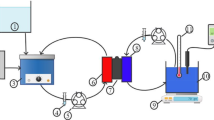Abstract
Oily wastewaters are produced in large amounts in many fields of food, mechanical, and other types of industry. In order to protect the environment, wastewaters must not be discharged directly into sewers. First, they must be cleaned at least down to 50 mg L−1 of oil content (according to Hungarian standard). In previous research, the authors found that oil-in-water emulsions can be separated with filtration using ceramic ultrafiltration tubular membranes. The relatively high price of ceramic membranes can be compensated by the fact that this separation process can be significantly intensified by static mixers inside the tubular membranes. New generations of ceramic membranes are the ceramic capillary membranes. These two different types of membranes and their effects on permeate flux, oil retention and specific energy consumption were compared in this work. The results, obtained with a stable oil-in-water emulsion as feed, showed that the use of novel ceramic capillary membranes at optimal operating cross-flow rate and transmembrane pressure is reasonable. The results have also shown the advantage of static mixing in the lumen side of the membrane tube providing a wider range of satisfactory separation level and increased permeate flux.
Similar content being viewed by others
References
Bodzek, M., & Konieczny, K. (1998). Comparison of ceramic and capillary membranes in the treatment of natural water by means of ultrafiltration and microfiltration. Desalination, 119, 191–197. DOI: 10.1016/S0011-9164(98)00150-7.
Box, G. E. P., Hunter, W. G., & Hunter, J. S. (1978). Statistics for experimenters: An introduction to design, data analysis, and model building. New York, NY, USA: Wiley.
Ebrahimi, M., Willershausen, D., Ashaghi, K. S., Engel, L., Placido, L., Mund, P., Bolduan, P., & Czermak, P. (2010). Investigations on the use of different ceramic membranes for efficient oil-field produced water treatment. Desalination, 250, 991–996. doi: 10.1016/j.desal.2009.09.088.
Ezzati, A., Gorouhi, E., & Mohammadi, T. (2005). Separation of water in oil emulsions using microfiltration. Desalination, 185, 371–382. doi: 10.1016/j.desal.2005.03.086.
Gepert, V., Kilgus, M., Schiestel, T., Brunner, H., Eigenberger, G., & Merten, C. (2006). Ceramic supported capillary Pd membranes for hydrogen separation: Potential and present limitations. Fuel Cells, 6, 472–481. doi: 10.1002/fuce.200600018.
Hu, X. G., Mora, J., Koris, A., Békássy-Molnár, E., & Vatai, G. (2002). Effect of transmembrane pressure on ultrafiltration behaviour of emulsified oily wastewater. In 15th International Congress of Chemical and Process Engineering (CHISA), 25–29 August 2002 (Book 2. Separation processes, pp. 259–260, Poster P 3.73). Prague, Czech Republic.
Jokić, A., Zavargo, Z., Šereš, Z., & Tekić, M. (2010). The effect of turbulence promoter on cross-flow microfiltration of yeast suspensions: A response surface methodology approach. Journal of Membrane Science, 350, 269–278 doi: 10.1016/j.memsci.2009.12.037.
Kocherginsky, N. M., Tan, C. L., & Lu, W. F. (2003). Demulsification of water-in-oil emulsions via filtration through a hydrophilic polymer membrane. Journal of Membrane Science, 220, 117–128. DOI: 10.1016/S0376-7388(03)00223-0.
Krstić, D.M., Höflinger, W., Koris, A. K., & Vatai, G. N. (2007). Energy-saving potential of cross-flow ultrafiltration with inserted static mixer: Application to an oil-in-water emulsion. Separation and Purification Technology, 57, 134–139 doi: 10.1016/j.seppur.2007.03.023.
Krstić, D. M., Koris, A. K., & Tekić, M. N. (2006). Do static turbulence promoters have potential in cross-flow membrane filtration applications? Desalination, 191, 371–375 doi: 10.1016/j.desal.2005.06.043.
Lobo, A., Cambiella, á., Benito, J. M., Pazos, C., & Coca, J. (2006). Ultrafiltration of oil-in-water emulsions with ceramic membranes: Influence of pH and crossflow velocity. Journal of Membrane Science, 278, 328–334. doi: 10.1016/j.memsci.2005.11.016.
Myers, R. H., & Montgomery, D. C. (1995). Response surfaces methodology: Process and product optimization using designed experiments. New York, NY, USA: Wiley.
Smid, J., Avci, C. G., Günay, V., Terpstra, R. A., & Van Eijk, J. P. G. M. (1996). Preparation and characterization of microporous ceramic hollow fibre membranes. Journal of Membrane Science, 112, 85–90. DOI: 10.1016/0376-7388(95)00274-X.
Voigt, I., Fischer, G., Puhlfrüß, P., Schleifenheimer, M., & Stahn, M. (2003). TiO2-NF-membranes on capillary supports. Separation and Purification Technology, 32, 87–91. DOI: 10.1016/S1383-5866(03)00064-9.
Wang, D., Li, K., & Teo, W. K. (2000). Porous PVDF asymmetric hollow fiber membranes prepared with the use of small molecular additives. Journal of Membrane Science, 178, 13–23. DOI: 10.1016/S0376-7388(00)00460-9.
Way, J. D., & Roberts, D. L. (1992). Hollow fiber inorganic membranes for gas separation. Separation Science and Technology, 27, 29–41. doi: 10.1080/01496399208018863.
Wei, C. C., Chen, O. Y., Liu, Y., & Li, K. (2008). Ceramic asymmetric hollow fibre membranes-one step fabrication process. Journal of Membrane Science, 320, 191–197. doi: 10.1016/j.memsci.2008.04.003.
Author information
Authors and Affiliations
Corresponding author
Rights and permissions
About this article
Cite this article
Gaspar, I., Koris, A., Bertalan, Z. et al. Comparison of ceramic capillary membrane and ceramic tubular membrane with inserted static mixer. Chem. Pap. 65, 596–602 (2011). https://doi.org/10.2478/s11696-011-0045-y
Received:
Revised:
Accepted:
Published:
Issue Date:
DOI: https://doi.org/10.2478/s11696-011-0045-y




